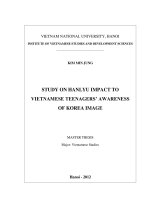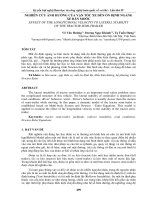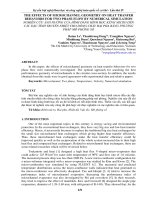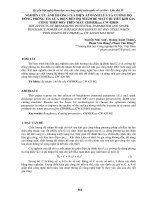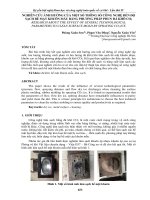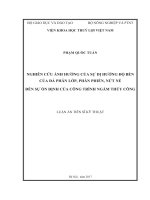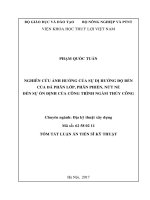THE EFFECTS OF MICROCHANNEL GEOMETRY ON HEAT TRANFER BEHAVIORS FOR TWO PHASE FLOW BY NUMERICAL SIMULATION NGHIÊN cứu ẢNH HƯỞNG của HÌNH DÁNG HÌNH học KÊNH MICRO đến các đặc TÍNH TRUYỀN NHIỆT CHO DÒNG CHẢY HAI PHA BẰNG PHƯƠNG PHÁP mô PHỎNG
Bạn đang xem bản rút gọn của tài liệu. Xem và tải ngay bản đầy đủ của tài liệu tại đây (553.8 KB, 6 trang )
Kỷ yếu hội nghị khoa học và công nghệ toàn quốc về cơ khí - Lần thứ IV
THE EFFECTS OF MICROCHANNEL GEOMETRY ON HEAT TRANFER
BEHAVIORS FOR TWO PHASE FLOW BY NUMERICAL SIMULATION
NGHIÊN CỨU ẢNH HƯỞNG CỦA HÌNH DÁNG HÌNH HỌC KÊNH MICRO ĐẾN
CÁC ĐẶC TÍNH TRUYỀN NHIỆT CHO DÒNG CHẢY HAI PHA BẰNG PHƯƠNG
PHÁP MÔ PHỎNG SỐ
Batan Le1, Thanhtrung Dang1a, Tronghieu Nguyen1,
Minhhung Doan1, Quochoai Nguyen1, Maicuong Bui1,
Vanhien Nguyen1, Thanhxuan Nguyen1, and Jyh-tong Teng2
1
Ho Chi Minh City University of Technology and Education, Vietnam
2
Chung Yuan Christian University, Taiwan
a
ABSTRACT
In this paper, the effects of microchannel geometry on heat transfer behaviors for two
phase flow were numerically investigated. The optimal approach for searching the best
performances geometry of microchannels is the circular cross-section. In addition, the results
obtained from this study were in good agreement with experimental data and relative papers.
Keywords: Microchannel, Two phase, Temperature, Velocity, Numerical simulation.
TÓM TẮT
Bài báo này nghiên cứu về ảnh hưởng của hình dáng hình học kênh micro đến các đặc
tính truyền nhiệt cho dòng chảy hai pha bằng phương pháp mô phỏng. Nghiên cứu này đã chỉ
ra được hình dáng hình học tối ưu đó là kênh có tiết diện hình tròn. Thêm vào đó, các kết quả
đạt được từ nghiên cứu này cũng rất phù hợp với thực nghiệm và các nghiên cứu có liên quan.
Từ khóa: Kênh micro, Hai pha, Nhiệt độ, Vận tốc, Mô phỏng số
1. INTRODUCTION
One of the most important topics in this century is energy saving and environmental
protection. In the conventional heat exchangers, they have very big size and low heat transfer
efficiency. Hence, it necessarily becomes to replace the traditional big size heat exchangers by
the small size microchannel heat exchangers which giving higher heat transfer efficiency.
Thus, these microchannel heat exchangers make the heat transfer efficiency could be
improved quickly as well as the reciprocation of the whole system increased due to their high
heat flux and compacted heat exchangers. Related to microchannel heat exchangers, there are
some related researches which will be reviewed below.
Tsukamoto and Imai [1] designed a high heat flux V-shaped micro-evaporator that
could achieve 125 W/cm2 for water inlet temperature of 900C and flow rate of 1.0 mL/min.
The measured pressure drop was less than 1000 Pa. A new micro-combustor configuration for
a micro-reformer integrated with a micro-evaporator was studied by Kim and Kwon [2]. The
micro-combustion was simulated by using FLUENT 6.2. The measured and predicted
temperature distributions across the micro-combustor walls indicated that heat generated in
the micro-combustor was effectively dissipated. Tuo and Hrnjak [3, 4] tried to increase the
performance index of microchannel evaporator. Increasing the performance index of
microchannel evaporator was also investigated by Shi and coworkers [5]. In their research,
they tried to improve the effect of manifolds. Kew and Cornwell [6] designed the single pipe
evaporators, diameter of 1.39–3.69 mm, with refrigerant of R-141b. They showed that, for the
631
Kỷ yếu hội nghị khoa học và công nghệ toàn quốc về cơ khí - Lần thứ IV
big diameter (2.87 and 3.69 mm), the heat transfer coefficient decrease steady or not change
when thermodynamic equilibrium quality x e increase (in case x e <0.2); However, it will
increase in case x e >0.2. For the small diameter 1,39mm, the heat transfer coefficient increase
when thermodynamic equilibrium quality x e increase (in case x e >0, low mass velocity);
However, it will decrease rapidly (in case x e >0, high mass velocity). Ravigururajan [7]
developed the rectangular shaped microchannel evaporator, with 54 parallel channels,
dimension of 0.27 x 1.0 mm, refrigerant of R-124, this evaporator could dissipate about 300
W. They showed that, the heat transfer coefficient decrease steady when increasing the
thermodynamic equilibrium quality x e (in case x e >0). Yan and Lin [8] developed the pipe
shaped evaporator, with 28 parallel pines, diameter of 2 mm, refrigerant of R-134a, this
evaporator could dissipate about 2 W/cm2. They showed that, the heat transfer coefficient
decrease steady when increasing the thermodynamic equilibrium quality x e (in case x e >0)
and was effected by heat flux, refrigerant saturation temperature, mass velocity.
Subsequent to the above literature reviews, it is important to clearly understand the
effects of microchannel geometry on heat transfer behaviors for two phase flow in order to get
an optimal design. For the present study, four heat exchangers with differences of cross
sections such as rectangular, trapezoidal, circle, V-shape will be discussed.
2. STRUCTURE DESIGN
The parallel microchannel heat exchangers using different microchannel cross-sections
are illustrated in Figure 1. It consists of manifolds and microchannels: all microchannels are
connected by manifolds. The water firstly from the inlet manifold flows through
microchannels, then going out of the system by outlet manifold. During its journey, it receives
amount of heat - which supplied by the outside sources - to become vapor at the outlet
manifold.
W2
H
W
Rectangular
R
H
H
W1
Trapezoidal
W
Triangular
Circle
Figure 1. A parallel microchannel heat exchanger and different microchannel
cross-sections
The material used for the substrate of heat exchangers is aluminum, with the thermal
conductivity of 237 W/(mK), density of 2,700 kg/ m3, and specific heat at constant pressure of
904 J/(kgK). For each microchannel heat exchanger, the top side has 20 microchannels. The
length of each microchannel is 120 mm. In a microchannel heat exchanger, all channels are
connected by manifolds. The manifolds of the heat exchangers have a rectangular crosssection with a width of 10 mm, a length of 19.5 mm and a depth of 1 mm. The distance
between two microchannel is 500 µm. The thickness of the substrate is 2 mm. To seal the
microchannels, the layer of PMMA (polymethyl methacrylate) was bonded on the top side of
the substrate. The PMMA has the thermal conductivity of 0.19 W/(mK) and density of 1,420
kg/m3. The Figure 2 shows the dimensions of a microchannel heat exchanger. Table 1
presents the summary of microchannel dimensions for differences cross section.
632
Kỷ yếu hội nghị khoa học và công nghệ toàn quốc về cơ khí - Lần thứ IV
Figure 2. The dimensions of a microchannel heat exchanger
Table 1. The summary of microchannel dimensions for different cross-section
W
H
R
Rectangular
500 µm
500 µm
Trapezoidal
W 1 = 125 µm
W 2 = 500 µm
800 µm
Triangular
500 µm
1 mm
5 µm
Circle
3. RESULTS AND DISCUSSION
As described above, finding the best performanced cross-section of microchannels for
two phase flow is the important task to determine the optimal design of two phase flow
microchannel heat exchangers. In this study, for the simulation, four microchannel heat
exchangers with differences type of cross sections such as rectangular, trapezoidal, circle, Vshape will be evaluated.
In order to study the effects of microchannel geometry on heat transfer behaviors for
two phase flow, all numerical simulation conditions or the four microchannel heat exchangers
were kept the same excepting changing the cross-section. Throughout the paper, four cases of
simulation were discussed: the first one for the Rectangular cross-section (case 1), the second
for the Trapezoidal cross-section (case 2), and the third for the Triangle cross-section (case 3)
and the last one for the Circle cross-section (case 4). The general parameters for these two
cases are summarized in Table 2.
Case
1
2
3
4
Table 2. General parameters for cases under study
Variable parameters
Fixed parameters
Rectangular cross-section: W=500µm, H=500µm Heat power: P source =176W
Inlet temperature: T in =30 °C
Trapezoidal cross-section
Ambiant temperature: T amb =30 °C
W 1 = 125 µm, W 2 = 500 µm, H= 800 µm
Source temperature: T s =120 °C
Triangle cross-section: W= 500 µm, H=1 mm
Mass flow rate: m = 0.3 g/s
Circle cross-section: R= 500 µm
Cross-section area: A=0.25 mm2
Figure 3 shows the location of full vaporization of the water in rectangular crosssectioned microchannels. It is observed that the flow rate in middle channels is larger than in
marginal channels, so the full vaporization of middle channels is slower than that obtained
from the marginal channels, leading to the vaporization profile is parabolic shape. For the
others case of 2-4, the results are almost the same.
633
Kỷ yếu hội nghị khoa học và công nghệ toàn quốc về cơ khí - Lần thứ IV
Figure 3. The location of full evaporation of the water, for case 1
Figure 4. The temperature distribution for the middle slice of the channel
Figures 4 and 5 show the thermal field and the curve of temperature during the length of
channel (for case 1 and middle slice of the channel), respectively. They show that the
maximum temperature of the sample is about 130 °C. Whereas, the maximum temperature of
fluid at the end of the channel is about 119 °C.
Figure 6 shows the comparison between the simulation and experiment about the
temperature in the case of inputs: heat power of 176W, ambient temperature of =30 °C, source
temperature of 30 °C, mass flow rate of 0.3 g/s, cross-section area of 0.25 mm2, substrate
thickness of 900 µm, depth of 500 µm. It is observed that the numerical results are in good
agreement with experimental results: the maximum percentage error is less than 0.3%.
634
Kỷ yếu hội nghị khoa học và công nghệ toàn quốc về cơ khí - Lần thứ IV
Temperature
X - Direction
Figure 5. The curve of temperature during the length of channel, for case 1 and middle
slice of the channel
Simuation
results
Experiment
results
Figure 6. Comparison between numerical simulation and experimental data
Heat flux
X - Direction
Figure 7. The comparision of heat flux for all of cases
635
Kỷ yếu hội nghị khoa học và công nghệ toàn quốc về cơ khí - Lần thứ IV
In addition, to determine the best performanced cross-section of microchannels for two
phase flow, the heat fluxes (x-direction) of the middle slice of the channel for case 2-4 are
also carried out by using COMSOL. Merging these results, the comparison of heat flux for all
of cases is shown in the Figure 7. It is easy to recognize that the case 4 with circular crosssection has higher heat flux than those obtained from others cases. The maximum heat flux is
about 1.152 x 108 W/ m2 .
CONCLUSION
The numerical simulation has been done on four microchannel heat exchangers with
differences type of cross sections to find out the effects of microchannel geometry on heat
transfer behaviors for two phase flow. In the study, it indicates that the microchannel heat
exchanger with the circle cross-section is the best choice for designing. There was less than
0.3% error between simulation and experiment; the results obtained from this study were in
good agreement with relative papers. Besides, maximum heat flux is about 1.152 x 108 W/ m2.
The maximum temperature at the end of the channel is about 119 °C.
REFERENCES
[1] T. Tsukamoto and R. Imai, Thermal characteristics of a high heat flux micro-evaporator,
Experimental Thermal and Fluid Science, Vol. 30, Issue 8, August 2006, pp. 837-842.
[2] K.B. Kim and O.C. Kwon, Studies on a two-staged micro-combustor for a microreformer integrated with a micro-evaporator, Journal of Power Sources, Volume 182,
Issue 2, 1 August 2008, pp. 609-615.
[3] Hanfei Tuo and Pega Hrnjak, Effect of the header pressure drop induced flow
maldistribution on the microchannel evaporator performance, International Journal of
Refrigeration, Volume 36, Issue 8, December 2013, pp. 2176-2186.
[4] Hanfei Tuo and Pega Hrnjak, New approach to improve performance by venting periodic
reverse vapor flow in microchannel evaporator, International Journal of
Refrigeration, Volume 36, Issue 8, December 2013, pp. 2187-2195.
[5] Junye Shi, Xiaohua Qu, Zhaogang Qi, Jiangping Chen, Investigating performance
of microchannel evaporators with different manifold structures, International Journal of
Refrigeration, Volume 34, Issue 1, January 2011, pp. 292-302.
[6] P.A. Kew, K. Cornwell, Correlations for the prediction of boiling heat transfer in small
diameter channels, Appl. Therm. Eng., Vol. 17, 1997, pp.705–715.
[7] T.S. Ravigururajan, Impact of channel geometry on twophase flow heat transfer
characteristics of refrigerants in microchannel heat exchangers, J. Heat Transfer, Vol.
120, 1998, pp. 485–491.
[8] Y.Y. Yan, T.F. Lin, Evaporation heat transfer and pressure drop of refrigerant R-134a in
a small pipe, Int. J. Heat Mass Transfer, Vol. 41, 1998, pp. 4183–4194.
AUTHOR’S INFORMATION
Thanhtrung Dang
HCMC University of Technology and Education
0913.606261
636

